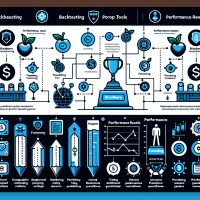Introduction: Unveiling the Comparative Edge in Prop Trading
In today’s competitive prop trading arena, making the right platform choice is fundamental to a trader’s success. This comprehensive guide focuses on the detailed comparison of Blueberry vs City Traders Imperium account sizes and platform options, offering actionable insights for both budding and experienced prop traders. By exploring these platforms, we aim to reveal nuanced differences that can refine your trading strategies and risk management techniques.
Comparing Account Sizes and Platform Options
The core of prop trading lies in the scales and tools available. Both Blueberry and City Traders Imperium offer unique account sizes catering to varying risk profiles, from the junior trader stepping in for the first time to senior quants managing multi-million dollar portfolios. A detailed side-by-side platform comparison is crucial for understanding which setup best aligns with your trading style.
Account Sizes: Tailoring to Trader Profiles
Blueberry: Blueberry provides a flexible tiered account system, starting from smaller accounts ideal for graduates of proprietary trading programs. As the risk tolerance rises, so does the capital allocation, making it a suitable choice for teams that require scalability and custom risk management tools.
City Traders Imperium: Known for larger minimum accounts, City Traders Imperium is tailored for experienced prop traders and institutional settings. Their account sizes often support higher leverage, designed for traders accustomed to quantitative models and algorithmic strategies.
Platform Options: Tools Designed for Efficiency and Robust Analysis
Both platforms have invested in technology and integrations to facilitate advanced trading practices. However, some key differences emerge:
- Blueberry Platform Options: These include customizable dashboards integrated with TradingView and NinjaTrader interfaces. Their focus is on real-time data integration, comprehensive risk analytics, and adaptive user-defined strategies.
- City Traders Imperium Platform Options: Leveraging platforms like QuantConnect and Interactive Brokers, this option provides advanced backtesting modules and robust API access. It excels at automated parameter optimization and stress testing for complex, high-frequency strategies.
Advanced Backtesting and Risk Management for Prop Trading Success
In prop trading, past performance is critical to shaping future strategies. One of the most powerful features of these platforms is automated backtesting. Using advanced tools like MetaTrader 5 and Backtrader, both platforms provide an environment to simulate real market conditions:
Common Pitfalls in Backtesting
Traders often face issues such as overfitting, survivorship bias, and look-ahead bias. To mitigate these, both platforms offer comprehensive data sourcing and robust simulation models. For instance, walk-forward optimization is a method where you continuously retrain your model on a rolling basis, minimizing biases associated with static datasets.
Walk-Forward Optimization vs. Traditional Backtesting
While traditional backtesting relies solely on historical data, walk-forward optimization (supported by platforms like NinjaTrader) dynamically adjusts parameters based on evolving market conditions. This approach not only refines strategy parameters but also prepares traders for real-time execution challenges.
Out-of-Sample Testing and Integration with Forward Testing
To ensure reliability, traders are encouraged to conduct out-of-sample testing followed by paper trading before live deployment. Tools such as TradingView allow you to overlay forward testing results with historical performance, offering a clear picture of potential risks and returns. Key performance metrics, including Sharpe Ratios, maximum drawdown, and profit factors, are continuously monitored.
Tool Recommendations and Detailed Comparisons
Both platforms integrate well with industry-standard automated backtesting tools. Below is an in-depth look at some of these tools that are vital for prop trading:
| Tool | Backtesting Features | Data Quality | Integration | Pricing & Use Cases |
|---|---|---|---|---|
| TradingView | Vectorized testing, script optimization, handling of commissions/slippage | Extensive historical data with real-time feeds | APIs, broker integrations, social trading community | Free tier available; ideal for individual traders and collaborative teams |
| MetaTrader 5 | Event-driven testing, multi-threaded processing, scenario analysis | High-quality broker-specific historical data | Robust API, algorithm integration, broker connectivity | Cost-effective with trial options; suitable for both retail and institutional traders |
| QuantConnect | Automated parameter optimization, stress testing, advanced report generation | Committed historical data for diverse asset classes | Comprehensive API, integration with popular analytics tools | Subscription-based; targeted at prop firms and quantitative traders |
Case Study: Enhancing Strategy Performance
One established prop trading firm recently upgraded its backtesting processes using these advanced platforms. Their initial challenges included overfitting and slow iteration times. By adopting a combination of TradingView for preliminary strategy mapping and Backtrader for detailed out-of-sample analysis, they achieved remarkable results:
- Improved Sharpe Ratio by 15% over a six-month period.
- Reduced maximum drawdown significantly by calibrating risk parameters through walk-forward optimization.
- Accelerated iteration times by automating parameter optimization, allowing quicker strategy refinements.
Python Code Example with Backtrader
import backtrader as bt
class MyStrategy(bt.Strategy):
def __init__(self):
self.sma = bt.indicators.SimpleMovingAverage(self.data, period=15)
def next(self):
if self.data.close[0] > self.sma[0]:
self.buy()
elif self.data.close[0] < self.sma[0]:
self.sell()
cerebro = bt.Cerebro()
cerebro.addstrategy(MyStrategy)
# Add data, set parameters, run backtest
cerebro.run()
Enhanced Visual Insights and Further Analysis
Visual data is critical in prop trading. After solidifying your strategy with backtesting, graphical insights can reveal even deeper market trends. Use screenshots of your trading tool's interface to compare backtesting reports. For example, a clear chart showing drawdown and Sharpe ratios over time emphasizes the reliability of a strategy.
Pro Tips for Prop Trading Success
Industry Insights: Always integrate out-of-sample testing and live forward testing. A well-documented trading journal and risk management checklist are indispensable. Track your performance metrics diligently and adjust trading algorithms based on evolving market data.
Regulatory and Compliance Considerations
Prop trading is not just about high returns; it also demands adherence to strict regulatory frameworks such as MiFID II, ESMA, and NFA rules. Ensure your trading strategies accommodate these compliance standards, especially when experimenting with new tools or scaling up your operations.
Conclusion: Next Steps in Your Prop Trading Journey
This exploration of Blueberry vs City Traders Imperium account sizes and platform options is designed to empower you with tangible strategies and state-of-the-art backtesting techniques. For deeper insights into risk management, please refer to our detailed Risk Management Checklist or visit our article on Advanced Prop Trading Strategies.
Embrace a proactive, data-driven approach to transform your trading performance and stay ahead in the competitive field of prop trading. As of October 2023, the tools and techniques discussed here remain at the cutting edge of the industry.
Call to Action: To further refine your strategies, consider joining our upcoming webinar on advanced backtesting methods and interactive risk management techniques. Your trading success begins with informed decisions and the right tools!







